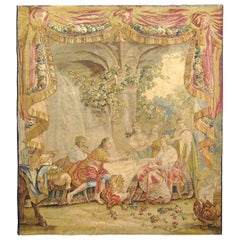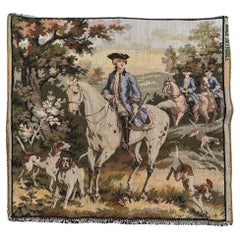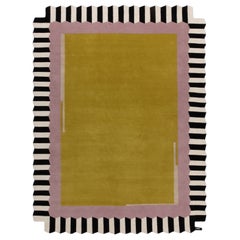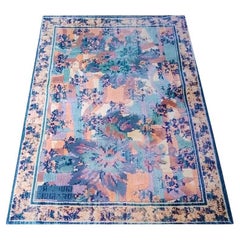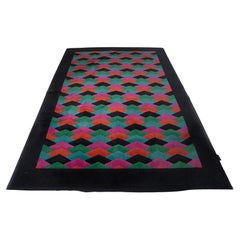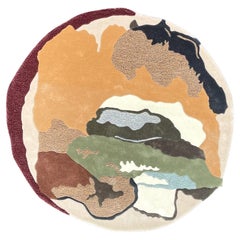Wool Western European Rugs
to
1,348
Width
to
Length
to
3,602
2,810
67
1,477
346
328
163
116
38
34
33
29
21
11
11
9
9
8
6
3
2
392
648
2,562
2,877
711
1,228
493
92
51
145
94
74
128
169
144
69
96
7,471
6,479
1,291
1,003
199
3,287
2,718
6,479
4,686
5,141
4,251
2,022
1,714
1,286
809
415
91
71
69
66
Material: Wool
18th Century French Aubusson Mythological Tapestry, with Telemachus & Calypso
Located in New York, NY
A French Aubusson tapestry which is very likely part of a set from 'The Story of Telemachus' woven at Aubusson between 1776 and 1800 after engraved designs by various painters including Franc¸ois Boucher Antonio Tempesta and Charles Monnet...
Category
18th Century French Antique Wool Western European Rugs
Materials
Wool
$44,995 Sale Price
30% Off
Nice vintage French Aubusson Style Jacquard Tapestry cushion face
Located in Saint Ouen, FR
"Pretty small French tapestry from the late-20th century, featuring a beautiful design and nice colours, woven in jacquard loom by wool acrylic a...
Category
Late 20th Century French Aubusson Wool Western European Rugs
Materials
Wool, Cotton, Acrylic
$170 Sale Price
20% Off
cc-tapis Dentelle Hexagone Pain d'Epices Hand-knotted Rug
By cc-tapis
Located in New York, NY
Dim ft 7,5x9,8 -- al ft2 117,00
(size tolerance +/-2%, fringes are not included)
handknotted
himalayan wool and silk
-8600A (125.000 knots/sqm approx.)
(colors may appear different f...
Category
2010s European Wool Western European Rugs
Materials
Wool
1990s Gorgeous Rug by Giorgetto Giugiaro for Paracchi. Pure wool. Made in Italy
Located in Milano, IT
1990s Gorgeous Rug by Giorgetto Giugiaro for Paracchi. Pure wool. Made in Italy.
It's in excellent condition and has been professionally washed and disinfected and is ready for use. ...
Category
1990s Italian Mid-Century Modern Wool Western European Rugs
Materials
Wool
Italian postmodern rug by MiSSONI, label present
Located in Milano, IT
Explore the iconic aesthetic of the 1980s with this postmodern Italian rug by Missoni, an authentic expression of the boldest and most creative interior design of the 20th century. M...
Category
1980s Italian Post-Modern Vintage Wool Western European Rugs
Materials
Wool
Vanilla Fraise Abstract Irregular Round Shape Hand-Tufted Rug by RAG Home
By RAG home
Located in Jakarta Selatan, ID
' Vanille Fraise ' contemporary irregular round shape hand-tufted Viscose wool rug by RAG Home
Original Designed by Rannisa Soraya from RAG Home
Hand-tufted with mixed Methods and C...
Category
2010s Indonesian Modern Wool Western European Rugs
Materials
Wool
$1,440 Sale Price / item
20% Off
Contemporary Irregular Abstract Shape Hand Tufted Rug by RAG Home
By RAG home
Located in Jakarta Selatan, ID
'Mis-Shapes'
Contemporary irregular abstract shape hand-tufted Viscose wool rug
A combination of neatness and abstraction. A fluid patterns and shades of primary colors from vibran...
Category
2010s Indonesian Modern Wool Western European Rugs
Materials
Wool
$1,680 Sale Price / item
20% Off
cc-tapis Giudecca Rug by Zanellato/Bortotto
By cc-tapis
Located in Brooklyn, NY
Hand knotted in the cc-tapis atelier in Kathmandu, Nepal. The rug is made with a cotton weave a Himalayan wool and pure silk coming from the areas surrounding the atelier. 152.000 in...
Category
21st Century and Contemporary Nepalese Modern Wool Western European Rugs
Materials
Wool, Silk
$7,877 / item
18th Century Flemish Verdure Tapestry
Located in New York, NY
A Flemish verdure landscape tapestry panel from the 18th century, featuring a verdant scene with large trees and various foliage and including a lake. Enclosed within a stylized bord...
Category
18th Century European Antique Wool Western European Rugs
Materials
Wool
$11,995 Sale Price
46% Off
Antique French Savonnerie Carpet, Red Field
Located in New York, NY
The madder red field features an allover pattern of laurel wreaths surrounding either complex rosettes or leaf and star arrays. The burnt apricot and camel border displays tight flor...
Category
Early 20th Century French Neoclassical Wool Western European Rugs
Materials
Wool
Vintage Signed Märta Måås-Fjetterström Brown Floral Wool Swedish Rug
Located in West Hollywood, CA
This vintage signed mid-century Swedish rug features a soft chocolate-brown field with five rows of nine light-blue quartered but linked squares forming larger squares alternating wi...
Category
Late 20th Century Swedish Wool Western European Rugs
Materials
Wool
Italian Modern Space Age Round Rug, Italy 70s
Located in Lucija, SI
Round rug made in the space age period
Made in Italy in the 70s
Category
1970s Italian Space Age Vintage Wool Western European Rugs
Materials
Wool, Acrylic
1970s Stunning Space Age Rug in Wool. Made in Italy
Located in Milano, IT
1970s Stunning space age rug with an awesome design. Pure wool made in Italy. It's excellent condition.
The rug has been professionally washed and disinfected and is ready for use.
...
Category
1970s Italian Mid-Century Modern Vintage Wool Western European Rugs
Materials
Wool
Antique English Needlepoint Tristan and Isolde Tapestry with Medieval Style
Located in Dallas, TX
78092 Antique English Needlepoint Tristan and Isolde Tapestry with Medieval Style 02'04 x 03'05. Drawing inspiration from Viking love-romance history and Celtic legend, this handwoven wool antique English needlepoint tapestry beautifully embodies Medieval style. The wall tapestry depicts Isolde and Tristan drinking the love potion. This is a Petit Point with metallic thread (possibly silver/gold). The colors join to create a truly compelling dance, and inaudibly speak with a timeless voice that is characterized by sensual decadence, as well as by stately action. All facets of this piece collectively entwine to form the striking and grand charm of a textile that is worthy to depict the tender, emotive, and vibrant details of humans and histories, no longer known. With its commitment to tradition and heart full of whimsy, this Medieval style tapestry...
Category
Early 20th Century English Medieval Wool Western European Rugs
Materials
Wool
Transitional Savonnerie Handmade Wool Rug With Spanish Design
Located in Norwalk, CT
Beautiful antique-style Savonnerie hand-knotted wool rug with a beige and sage green color field. This piece has a designed brown frame and multicolor accents in a gorgeous medallion...
Category
21st Century and Contemporary Romanian Spanish Colonial Wool Western European Rugs
Materials
Wool
$10,725 Sale Price
25% Off
Pretty small 20th century french Aubusson tapestry
Located in Saint Ouen, FR
Very beautiful 20th century Aubusson tapestry with a design of tapestries from 18th or 18th centuries, with the nature and with trees with bird and the river, a country house behind,...
Category
1970s French Aubusson Vintage Wool Western European Rugs
Materials
Wool, Silk
$1,138 Sale Price
20% Off
Fine Portuguese Needlepoint Rug from the Arraiolos Factory, 1940s
Located in Rome, IT
Light pastel blue and beige Portuguese carpet. Interlaced flowers and garlands make up the design of the central field and other decorative elements. This carpet is ideal for a large...
Category
Early 20th Century Portuguese Wool Western European Rugs
Materials
Wool
Nice modern French Aubusson Tapestry by « Lartigaud »
Located in Saint Ouen, FR
Discover the elegance of modern French tapestry with the exquisite "Floride" (Florida) design by Jean Michel Lartigaud. This limited edition masterpiece, woven in vibrant shades of o...
Category
Mid-20th Century French Modern Wool Western European Rugs
Materials
Wool, Cotton, Silk
$3,344 Sale Price
20% Off
Pretty antique 17th century French Aubusson Tapestry fragment
Located in Saint Ouen, FR
"Exquisite fragment of a border of a French Aubusson tapestry from the middle of the 17th century, featuring a beautiful design of flowers and nice natural colours, entirely hand wov...
Category
Mid-17th Century French Aubusson Antique Wool Western European Rugs
Materials
Wool, Silk
$616 Sale Price
20% Off
Wool Rug 1950s Hand Tufted Abstract Design
Located in London, GB
Mid-Century Modern wool hand tufted pile rug is like an abstract expressive painting of circular overlapping swirls of changing colors, Europe circa 1950. The ingenious color variati...
Category
1950s European Mid-Century Modern Vintage Wool Western European Rugs
Materials
Wool
Bobyrug’s Pretty Mid Century French Needlepoint Tapestry
Located in Saint Ouen, FR
Exquisite French needlepoint tapestry featuring a stunning garden design with birds and vibrant colors. Hand-embroidered using the needlepo...
Category
Mid-20th Century French Aubusson Wool Western European Rugs
Materials
Wool
$1,195 Sale Price
20% Off
Pretty fine large antique french Aubusson tapestry
Located in Saint Ouen, FR
Very beautiful late 19th century French Aubusson tapestry with a nice design of a village, with nature, trees, birds, a river, chickens. a mill on the edge of the river, village hous...
Category
Late 19th Century French Aubusson Antique Wool Western European Rugs
Materials
Wool, Silk
$7,114 Sale Price
20% Off
Vintage Romanian Kilim Rug with Folk Art Style
Located in Dallas, TX
77805 vintage Romanian Kilim rug with Folk Art style 04'02 x 06'00. Emanating charm with an expressive design, this hand woven wool vintage Romanian...
Category
Late 20th Century Romanian Kilim Wool Western European Rugs
Materials
Wool
Pretty antique french Aubusson tapestry panel
Located in Saint Ouen, FR
Very beautiful antique French Aubusson tapestry fragment featuring flowers and trees With nice natural colours in the hues of yellow, green, pink, purple and brown, entirely hand wov...
Category
Late 19th Century French Aubusson Antique Wool Western European Rugs
Materials
Wool
$2,101 Sale Price
20% Off
Saporiti "Rationalisms" carpet 1990s. Italy
By Saporiti
Located in Firenze, FI
Carpet created by the Saporiti studio in the 1990s with dimensions 240 cm. x 140 cm. Part of the collection "Rationalisms" with an abstract and modern design. The composition featur...
Category
1990s Italian Wool Western European Rugs
Materials
Wool
Mid-20th Century Belgian Art Deco Room Size Carpet
Located in New York, NY
A Vintage Belgian Art Deco room size carpet handmade during the Mid-20th century.
Measures: 11' 2" x 14' 6"
Category
Mid-20th Century Belgian Art Deco Wool Western European Rugs
Materials
Wool
Large Art Line Rug After Pablo Picasso Hand Knotted Wool Excellent Condition
Located in Lohr, Bavaria, DE
A beautiful vintage design carpet by ART LINE, hand knotted using finest Tibetan wool in 6.6 x 9.6 ft / 300 x 200 cm, Design after Pablo Picasso
Cubism is a style in art history that developed from the avant-garde in painting in France around 1906. Well-known founders are Pablo Picasso and Georges Braque.
This vintage rug is in excellent condition and a rare piece on the market.
The feel is soft and cozy thanks to the use of the fine material. The rug is approx. 1/4-1/3 inch high.
Cubistic design carpet hand knotted.
Collection: Djoharian Design
Colors: Orange, Beige, Blue
Pile: Wool
Size: 300 x 200 cm
Fringe: Yes, on both sides
Underfloor heating: Suitable
Perfect for loft or Industrial modern rooms...
Category
1990s Nepalese Modern Wool Western European Rugs
Materials
Wool
$8,537 Sale Price
20% Off
Contemporary Terracotta Beige Lines Tufted Rug by Rag Home
By RAG home
Located in Jakarta Selatan, ID
This rug will fulfil that dream to your imagination - and your space.
Original Designed by Rannisa Soraya RAG Home Jakarta
Hand-tufted with mixed Methods ...
Category
2010s Indonesian Modern Wool Western European Rugs
Materials
Wool, Acrylic
cc-Tapis Pipeline Wallhanging 1 Rug by Patricia Urquiola
Located in Brooklyn, NY
Research which began with the Slinkie Collection for cc-tapis, Pipeline is the translation of Urquiola’s digital artworks into an artisanal product. A series of connected tubes emerg...
Category
21st Century and Contemporary Nepalese Modern Wool Western European Rugs
Materials
Wool
Pretty early 20th century French Aubusson style Jacquard Tapestry
Located in Saint Ouen, FR
Very pretty antique french Aubusson style tapestry with beautiful design from the nature with an eagle. Woven on Jacquard loom with wool and cotton.
✨✨✨
"Experience the epitome of lu...
Category
Early 20th Century French Aubusson Wool Western European Rugs
Materials
Wool, Cotton
$1,792 Sale Price
20% Off
Antique Donegal Irish Rug. 10 ft 2 in x 10 ft 4 in (3.1 m x 3.15 m)
Located in New York, NY
Beautiful square size antique Donegal Irish rug, country of origin: Ireland, circa 1920. Size: 10 ft 2 in x 10 ft 4 in (3.1 m x 3.15 m)
Delicate b...
Category
Early 19th Century Irish Arts and Crafts Antique Wool Western European Rugs
Materials
Wool
Early 20th Century Donegal Arts & Crafts Carpet Designed by C.F.A. Voysey
Located in New York, NY
Early 20th Century Donegal Arts & Crafts Carpet " The Donnemara "
Designed by C.F.A. Voysey
12'6" x 14'8" - 380 x 445 cm
Category
Early 1900s Irish Arts and Crafts Antique Wool Western European Rugs
Materials
Wool
$51,000 Sale Price
25% Off
French Aubusson Design Rug 5'11'' x 9'0"
Located in New York, NY
French Aubusson Design Rug 5'11'' x 9'0". The near black field explodes with six large tropical flower and giant leaf roundels enclosing colorful birds; and two smaller end reserves...
Category
21st Century and Contemporary French Wool Western European Rugs
Materials
Wool, Cotton
Hand-Knotted Figurative Roman Rug & Tapestry Made from Wool, Silk and Linen (L)
Located in Wien, AT
Fragment III, Dinodo Studio in collaboration with Dominik Scharfer, is a captivating piece from the Preliminary Aftershocks collection. Inspired by the evocative ruins of ancient Rom...
Category
21st Century and Contemporary Italian Modern Wool Western European Rugs
Materials
Wool, Linen, Silk
Vintage French Aubusson Chinese Needlepoint Carpet, 09'11 x 13'09
Located in Dallas, TX
77205 Vintage French Aubusson Floral Trellis Needlepoint Chinese Rug with Chintz Style. Drawing inspiration from Mario Buatta and Chintz style, thi...
Category
Late 20th Century Chinese Aubusson Wool Western European Rugs
Materials
Wool
Handmade Antique Persian Sarouk Rug – 12.1' x 8.9' (370 x 270 cm), 1900s 1K02
Located in Bordeaux, FR
A magnificent antique Persian Sarouk rug, hand-knotted from fine wool, showcasing a classic Kashan design with intricate floral motifs and rich, harmonious tones. Dating back to the ...
Category
Early 1900s German Antique Wool Western European Rugs
Materials
Wool
Antique French Tapestry Exotic Flowers Animals Rare Black Verdure 3x6 92 x 168cm
Located in New York, NY
Antique French Tapestry Exotic Flowers Animals Rare Black Verdure 3x6
92cm x 168cm
A magnificent antique French tapestry depicting a scene of verdure. This is an easy, chic addition...
Category
1920s French Baroque Vintage Wool Western European Rugs
Materials
Wool
Irregular Shape Contemporary Rug with Red, Pink, Blue 'Winter Rose' by Rag Home
By RAG home
Located in Jakarta Selatan, ID
A harmonious amalgamation of artistry and nature, 'Winter Rose' by RAG Home is an abstract rendition that unveils the essence of a single rose blossom in December. Delicate shades of...
Category
2010s Indonesian Modern Wool Western European Rugs
Materials
Wool, Acrylic, Yarn
cc-tapis Rug Bliss Round in Forest by Mae Engelgeer
Located in Brooklyn, NY
Born in France. Designed in Milan. Produced in Nepal.
cc-tapis is an Italian company which produces contemporary hand-knotted rugs which are created in Nepal by expert Tibetan artis...
Category
21st Century and Contemporary Nepalese Modern Wool Western European Rugs
Materials
Wool, Silk
$12,574 / item
Pretty mid 20th century french Aubusson tapestry « autumn ferns » by Le Guen
Located in Saint Ouen, FR
Discover the timeless elegance of the Fougères d’Automne « autumn ferns » titled limited edition wall tapestry from Manufacture Robert Four in Aubusson, France. This exquisite piece,...
Category
Mid-20th Century French Aubusson Wool Western European Rugs
Materials
Wool, Cotton
$3,344 Sale Price
20% Off
Antique French Aubusson Rug Hand Woven 1880 6x7ft Traditional 178cm x 206cm
Located in New York, NY
Antique French Aubusson Rug Hand Woven 1880 6x7ft Rare Design 178cm x 206cm
"This is a great example of an authentic antique French Aubusson rug. This is a very fine, flat woven pie...
Category
1880s French French Provincial Antique Wool Western European Rugs
Materials
Wool
Bobyrug’s Pretty vintage french Aubusson style Jaquar tapestry
Located in Saint Ouen, FR
Very beautiful mid century French tapestry with beautiful design of nature with birds and a palace, with beautiful colors, mechanical Jaquar manufacturing with wool.
✨✨✨
"Experience...
Category
Mid-20th Century French Aubusson Wool Western European Rugs
Materials
Wool
$1,447 Sale Price
20% Off
Beautiful Vintage French Jaquar Tapestry basket of flowers design
Located in Saint Ouen, FR
Exquisite vintage French Aubusson style tapestry, with beautiful design of a basket of flowers and beautiful colours with a red background, pink, orange, yellow, blue green and white...
Category
Late 20th Century French Aubusson Wool Western European Rugs
Materials
Wool, Cotton
$844 Sale Price
20% Off
Late 18th Century French Aubusson Verdure Tapestry with Louis XV Style
Located in Dallas, TX
78236 Late 18th Century Antique French Aubusson Verdure Tapestry, 04'01 x 06'00. Bathed in the soft glow of Rococo refinement, this handwoven antique French Aubusson tapestry from th...
Category
Late 18th Century French Aubusson Antique Wool Western European Rugs
Materials
Wool
Irregular Shape Hand-Tufted Wool Rug 'Kembang Setaman' by RAG Home
By RAG home
Located in Jakarta Selatan, ID
Irregular shape hand-tufted wool rug 'Kembang Setaman' by RAG Home
A modern and abstract interpretation of traditional savoir-faire craftsmanship - the art of embroidery. Like a flo...
Category
21st Century and Contemporary Indonesian Modern Wool Western European Rugs
Materials
Wool
Modern Art Deco Rug by Doris Leslie Blau
Located in New York, NY
Modern Art Deco Rug by Doris Leslie Blau
Size: 19'7" × 24'10" (596 × 756 cm)
This high-end modern rug is a standout piece from Doris Leslie Blau Collection. It is hand knotted in woo...
Category
21st Century and Contemporary European Art Deco Wool Western European Rugs
Materials
Wool
Antique Donegel Voysey Rug in Red with Colorful Floral Pattern - Rug & Kilim
Located in Long Island City, NY
Made with hand-knotted wool and originating from Ireland circa 1910-1920, this antique Donegel Voysey rug is a 13x14 collectible from the revered arts and crafts movement
On the Des...
Category
1910s Irish Arts and Crafts Vintage Wool Western European Rugs
Materials
Wool
Doris Leslie Blau Antique English Axminster Rug
Located in New York, NY
Antique English Axminster Rug
Size: 10'2" × 14'0" (309 × 426 cm)
This exquisite Antique Axminster rug, woven in England around 1910, showcases the timeless elegance and craftsmanship...
Category
Early 20th Century English Wool Western European Rugs
Materials
Wool
1960 Vintage Art Nouveau Tapestry Abstract Fish Handwoven 2x4
Located in New York, NY
1960 Vintage Art Nouveau Tapestry Abstract Fish Handwoven 2x4
About Us~
Welcome to Antique Rug Collection. Your #1 Source for handmade Antique Rugs & Tapestries at great prices, cu...
Category
1950s French Baroque Vintage Wool Western European Rugs
Materials
Wool
Rectangular Metamorphosis Wool and Art Silk Rug FB Collection
Located in Milan, IT
This beautiful, beige-toned rug made from wool and artificial silk has been hand-tufted. Throw this rectangular rug into the floor of any home or office space for a bit of added eleg...
Category
2010s Italian Wool Western European Rugs
Materials
Wool, Silk
Botanical Carpet Aubusson Rug Green Handwoven Wool Needlepoint Livingroom Rug
Located in Wembley, GB
This fantastic area rug has a beautiful botanical and floral design woven on an ivory, green, and blue background with cream-green and ivory accents. This elegant piece's colour and ...
Category
1990s French Aubusson Wool Western European Rugs
Materials
Wool, Cotton, Organic Material
$5,268 Sale Price
20% Off
Antique Arraiolos Rug with European Country Charm, Portuguese Needlepoint Rug
Located in Dallas, TX
77210 Antique Portuguese Needlepoint Arraiolos Rug, 07’11 x 11’02. Arraiolos rugs are a celebrated form of traditional Portuguese craftsmanship, originating from the town of Arraiolo...
Category
Early 20th Century Portuguese Country Wool Western European Rugs
Materials
Wool
cc-tapis Chateau Wiggle Stripe Rug by Luke Edward Hall
Located in Brooklyn, NY
Pure wool jacquard rug with design inspired by 1920s illustrations of jewellery discovered by Luke in a museum's collection. "Our four Chateau Orlando rug designs for cc-tapis are no...
Category
21st Century and Contemporary Nepalese Wool Western European Rugs
Materials
Wool
Beautiful 1960s French Hand Knotted Rug Signed Jacques Borker
Located in Saint Ouen, FR
Wonderful original French mid-20th century modern rug, with beautiful abstract design and nice colors with pink, yellow, black, blue and green, entirely hand knotted with wool velvet...
Category
Mid-20th Century French Modern Wool Western European Rugs
Materials
Wool
$3,320 Sale Price
20% Off
Early 18th Century Flemish Mythological Tapestry with Odysseus and Penelope
Located in New York, NY
A Flemish mythological tapestry from the late 17th or early 18th century, envisioning Odysseus and Penelope, in a scene from the culmination of The Odyssey. Measures: 11’0” H x 10’0”...
Category
Early 18th Century European Antique Wool Western European Rugs
Materials
Wool
$27,495 Sale Price
31% Off
Vintage Asger Oluf Jorn Expressionist Art Rug / Art LINE Ege Axminster Denmark
By Asger Jorn
Located in Buffalo, NY
An Exciting And Rare Vintage Asger Oluf Jorn Expressionist Art Rug, Country Of Origin / Rug Type: Vintage Scandinavian Rugs, Circa Date: Mid 20th Century – This fascinating and artis...
Category
1960s Danish Mid-Century Modern Vintage Wool Western European Rugs
Materials
Wool
Teklan Frame Wool Rug Mullberry Sky - Handtufted rug in Blue and Burgundy
Located in Stockholm, SE
This product is part of the Prism Palette collection, an exclusive collaboration between LAYERED and the Scandinavian visionary artist and designer Tekla Evelina Severin, known as Te...
Category
2010s Indian Wool Western European Rugs
Materials
Wool
Bobyrug’s Nice Vintage Aubusson Style French Tapestry
Located in Saint Ouen, FR
Nice mid century french mechanical tapestry with beautiful design of a 18th century aubusson tapestry with beautiful colors, woven with mechanical ...
Category
Mid-20th Century French Aubusson Wool Western European Rugs
Materials
Wool, Cotton
$1,195 Sale Price
20% Off
17th century Antique Aubusson/Gobelin tapestry, France Architectural land, silk
Located in Berlin, DE
17th century Antique Aubusson/Gobelin tapestry, France Architectural landscape, silk
Antique Museal Aubosson tapestry made of silk and partly wool. Very fine and antique design. Dep...
Category
17th Century French Baroque Antique Wool Western European Rugs
Materials
Wool, Silk
Knoll International carpet collection Model No. 8 Eye of Sigrid Wylach, 1980s
By Knoll
Located in Hannover, DE
Very rare carpet from Knoll International, collection Model No. 8 Eye of Sigrid Wylach. This round, very soft carpet with a 2cm pile made of pure, high-quality wool is a real eye-cat...
Category
1980s German Modern Vintage Wool Western European Rugs
Materials
Wool
$3,282 Sale Price
29% Off
Recently Viewed
View AllMore Ways To Browse
Castelli Platone
Cathedral Clock
Cenedese Aquarium
Ceramic Dogs Italy
Chelsea Pottery
Chi Rho
Chinese Han Dynasty Bronze Vase
Chinese Screen Inlay
Chinese Stacking Box
Chinese Wash Stand
Chinoiserie Dressing Table
Chippendale Highboy
Chippendale Mahogany Block Front
Christopher Walling Gold
Cigarette Compact
Civil War Chest
Cobalt Blue Decanter
Coco House
